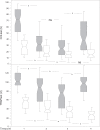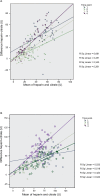Influence of the sample anticoagulant on the measurements of impedance aggregometry in cardiac surgery
- PMID: 22915904
- PMCID: PMC3417906
- DOI: 10.2147/mder.s3288
Influence of the sample anticoagulant on the measurements of impedance aggregometry in cardiac surgery
Abstract
Background: The standard method of assessment of platelet function is represented by light transmission aggregometry (LTA), performed in citrated platelet-rich plasma (PRP). With LTA, decrease and subsequent post-cardiopulmonary bypass (CPB) recovery of platelet function have been reported during cardiac surgery. Multiple electrode aggregometry (MEA) may be used as point-of-care method to monitor perioperative changes in platelet function. Since MEA assesses macroaggregation which is influenced by the plasmatic levels of unbound calcium, citrate may be inadequate as anticoagulant for MEA. We used citrate and heparin for MEA samples, to see with which anticoagulant the intraoperative decrease and postoperative recovery in platelet function previously described with other aggregometric methods in cardiac surgery may be observed with MEA.
Methods: Blood was obtained from 60 patients undergoing routine cardiac surgery and the samples were collected in standard tubes containing unfractionated heparin (50 U/mL) or trisodium citrate (3.2%). The samples were obtained before CPB, at 30 minutes on CPB, end of CPB and on the first postoperative day. MEA was performed using the Multiplate® analyzer. Collagen (COLtest, 100 μg/mL) and TRAP-6 (thrombin receptor activating peptide, TRAPtest, 1mM/mL) were used as aggregation agonists.
Results: Platelet aggregometric response decreased significantly during CPB. Platelet aggregation assessed using TRAP-6 as agonist on heparinized blood significantly correlated with the duration of CPB (r = -0.41, p = 0.001, 2-tailed Pearson test). The aggregometric analysis performed on the first postoperative day showed a significant recovery in platelet activity in the samples containing heparin (increase from 30 ± 22 U to 46 ± 27 U for the COLtest and from 70 ± 34 U to 95 ± 32 U for the TRAPtest, p < 0.001, Student's t-test), while no significant recovery of platelet function could be established in the MEA measurements performed with citrated blood.
Conclusions: The choice of blood sample anticoagulant used for impedance aggregometry influenced the platelet aggregation response. Postoperative platelet function recovery was only detected in the heparinized samples. Heparin seems to be better suited than citrate for the analysis of impedance aggregometry in heart surgery.
Keywords: cardiac surgery; impedance aggregometry; platelet recovery; sample anticoagulant.
Figures


Similar articles
-
Comparison of light transmission aggregometry and multiple electrode aggregometry for the evaluation of patients with mucocutaneous bleeding.Int J Lab Hematol. 2019 Feb;41(1):133-140. doi: 10.1111/ijlh.12937. Epub 2018 Oct 25. Int J Lab Hematol. 2019. PMID: 30358923
-
Diagnosis of Glanzmann thrombasthenia by whole blood impedance analyzer (MEA) vs. light transmission aggregometry.Int J Lab Hematol. 2015 Aug;37(4):503-8. doi: 10.1111/ijlh.12320. Epub 2014 Dec 24. Int J Lab Hematol. 2015. PMID: 25537026
-
Early platelet recovery following cardiac surgery with cardiopulmonary bypass.Platelets. 2016 Dec;27(8):751-757. doi: 10.3109/09537104.2016.1173665. Epub 2016 May 10. Platelets. 2016. PMID: 27164510
-
[Impact of acute normovolemic hemodilution on primary hemostasis].Anaesthesist. 2014 Jun;63(6):496-502. doi: 10.1007/s00101-014-2325-8. Epub 2014 May 14. Anaesthesist. 2014. PMID: 24820356 Review. German.
-
The predictive value of multiple electrode platelet aggregometry (multiplate) in adult cardiac surgery.Thorac Cardiovasc Surg. 2013 Dec;61(8):733-43. doi: 10.1055/s-0033-1333659. Epub 2013 Feb 18. Thorac Cardiovasc Surg. 2013. PMID: 23420333 Review.
Cited by
-
Assessment of Multiplate platelet aggregometry using citrate, heparin or hirudin in Rhesus macaques.Platelets. 2015;26(8):730-5. doi: 10.3109/09537104.2014.988694. Epub 2014 Dec 30. Platelets. 2015. PMID: 25549285 Free PMC article.
References
-
- Belcher PR, Muriithi EW, Milne EM, et al. Heparin, platelet aggregation, neutrophils, and cardiopulmonary bypass. Thromb Res. 2000;98:249–56. - PubMed
-
- Boldt J, Knothe C, Zickmann B, et al. Comparison of two aprotinin dosage regimens in pediatric patients having cardiac operations. Influence on platelet function and blood loss. J Thorac Cardiovasc Surg. 1993;105:705–11. - PubMed
-
- Boldt J, Schindler E, Osmer C, et al. Influence of different anticoagulation regimens on platelet function during cardiac surgery. Br J Anaesth. 1994;73:639–44. - PubMed
-
- Bretschneider E, Glusa E, Schror K. ADP-, PAF- and adrenaline-induced platelet aggregation and thromboxane formation are not affected by a thromboxane receptor antagonist at physiological external Ca++ concentrations. Thromb Res. 1994;75:233–42. - PubMed
LinkOut - more resources
Full Text Sources
Research Materials

